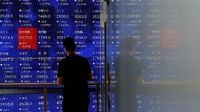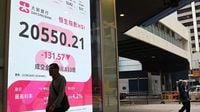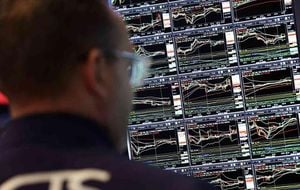Asian markets traded lower on Tuesday, April 22, 2025, following overnight losses on Wall Street. The decline came in the wake of U.S. President Donald Trump’s sharp criticism of Federal Reserve Chairman Jerome Powell, which raised concerns about the central bank's independence and dented confidence in the U.S. economy. Japan’s Nikkei 225 index fell by 0.4%, while the Topix index decreased by 0.2%. Notably, chip-related shares suffered losses, with Tokyo Electron and Advantest down by 1.24% and 1.56%, respectively. However, KDDI, a major phone company, saw a modest rise of 0.6%, becoming the biggest support for the Nikkei.
In South Korea, the Kospi index fell 0.34%, and the small-cap Kosdaq was marginally lower. Futures for Hong Kong’s Hang Seng index indicated a slightly weaker opening, reflecting the dampened global market sentiment. Trump’s pointed remarks about the Federal Reserve, particularly his assertion that the U.S. economy could slow down unless interest rates are lowered immediately, contributed to the overall negative sentiment in the markets.
The U.S. stock market experienced steep losses on Monday, April 21, 2025, with the Dow Jones Industrial Average plummeting by 971.82 points, or 2.48%, to close at 38,170.41. The S&P 500 index slipped by 124.50 points, or 2.36%, to finish at 5,158.20, while the Nasdaq Composite dropped 415.55 points, or 2.55%, closing at 15,870.90. This significant downturn came as investors reacted to Trump’s ongoing attacks on Powell and the Fed’s monetary policy, which rattled confidence and led to fears about the potential erosion of the Fed's independence.
As a result of these developments, the U.S. dollar index languished near its lowest level in three years, standing at 98.454 after sinking as low as 97.923, a level not seen since March 2022. The decline in the dollar was mirrored by a surge in safe-haven assets, including gold, which reached a record high of $3,430.18 an ounce during trading. Spot gold ultimately rose by 2.7% to $3,417.62 an ounce by the end of the trading day.
In the Indian stock market, benchmark indices such as the Sensex and Nifty 50 were also expected to open lower on Tuesday, following the negative trends in global markets. The trends on Gift Nifty indicated a similar outlook for domestic markets. On Monday, the Sensex had jumped 855.30 points, or 1.09%, closing at 79,408.50, while the Nifty 50 settled 273.90 points, or 1.15%, higher at 24,125.55.
In a wider context, the ongoing trade tensions between the U.S. and China have added to market volatility. Trump’s tariffs have unsettled financial markets, and the Sino-U.S. trade rift deepened after Beijing warned other nations against making agreements with the United States at China's expense. This backdrop has led to heightened anxiety among investors, particularly as they navigate the implications of Trump’s public criticism of the Federal Reserve.
Devarsh Vakil, Head of Prime Research at HDFC Securities, noted that Trump’s harsh critique of Powell, calling him "a major loser" and "Mr. Too Late" for not lowering interest rates faster, has rattled markets already grappling with trade war uncertainties. The pressure on the Federal Reserve to respond to political influence has raised concerns about its ability to maintain an independent monetary policy.
Meanwhile, the Ministry of Finance in India announced the imposition of a 12% provisional safeguard duty on certain steel products, effective immediately for a period of 200 days. This measure aims to protect the domestic industry from injuries caused by a recent spike in imports of such products. Additionally, the Reserve Bank of India (RBI) has relaxed some requirements of the new liquidity coverage ratio (LCR) framework, which is expected to free up lendable assets of approximately Rs 3 trillion, or 1.9% of banks' loans.
In the last eight trading sessions, the Nifty has risen more than 2,400 points from a recent swing low of 21,743. The Nifty Bank index also touched record highs on Monday, with the private sector bank gauge showing an 11% increase year-to-date, compared to a modest 1% rise for public sector banks. This indicates a strong buying interest in the banking sector, even amidst the turbulent global environment.
As the markets continue to react to these developments, investors are advised to remain cautious and stay informed about the evolving economic landscape. The ongoing dynamics between U.S. monetary policy and international trade relations will likely keep market participants on edge in the coming weeks.
In summary, the interplay between Trump’s criticism of the Federal Reserve and the ongoing trade tensions is shaping market sentiment significantly. As investors navigate this complex landscape, the independence of the Fed and its ability to respond to economic challenges without political pressure will be crucial in determining the future trajectory of both U.S. and global markets.






